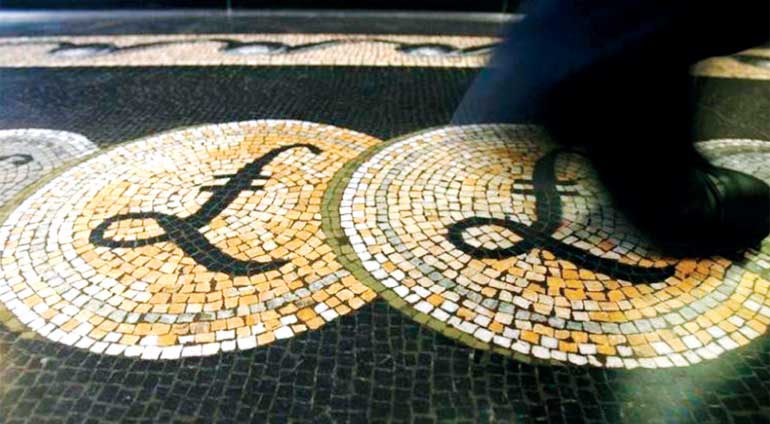Wednesday Feb 12, 2025
Wednesday Feb 12, 2025
Tuesday, 11 October 2016 00:02 - - {{hitsCtrl.values.hits}}
Sterling’s trade-weighted index fell to its lowest since early 2009 on Monday, extending hefty losses seen last week, on deepening worry about an adverse impact on the British economy from its exit from the European Union.
The currency was slightly calmer than Friday when a “flash-crash” wiped out a tenth of its value in a matter of minutes in Asian trade, but sentiment towards the pound remained gloomy with speculators bets against it at record highs.
Sterling index fell to 74.2 its lowest since Jan 2009 and down 0.7% on the day. The index has lost over 9% since the referendum results on 24 June where Britons voted to leave the EU.

An employee is seen walking over a mosaic of pound sterling symbols set in the floor of the front hall of the Bank of England in London, in this 25 March 2008 file photograph
The drop in the index reflected sterling’s broad struggles. It was down 0.2% against the dollar at $1.2410 while the euro was flat at 90 pence. Against the dollar, sterling hit a low of $1.1491 on Friday, its lowest since 1985, and posted its worst weekly loss since the Brexit vote.
Losses accelerated last week on worries about how Britain will exit the EU and about Prime Minister Theresa May’s comments on loose monetary policy, which some saw as a thinly veiled attack on the Bank of England.
Many investors think May’s government is leaning towards a “Hard Brexit”, where Britain gives up full access to the EU’s single market in order to impose maximum control on its borders. Some fear that could hinder trade and constrict the foreign investment needed to fund Britain’s huge current account deficit, one of the biggest in the developed world.
“’Hard’ Brexit fears are unlikely to abate anytime soon and in the near term there is scope for another 2-3% risk premium to be built into sterling/dollar and euro/sterling,” said Chris Turner, head of currency strategy at ING, adding last week saw an estimated 4-5% risk premium being priced in as per their financial models.
When investors are nervous or cautious about putting money into country’s assets they demand higher premiums for their investments which often can lead to a cheaper or weaker currency.
A few large banks have lowered their forecasts for the pound. HSBC, a leading British bank, said on Friday it forecast the pound to drop to $1.10 and parity against the euro by the end of 2017, citing growing uncertainty from Brexit.
Traders said sentiment was unlikely to turn around soon with the options market indicating some more weakness. Six-month sterling/dollar risk reversals, capturing the date by which Britain is expected to formally begin the process of leaving the EU, showing a bias for more weakness.
Risk reversals are a gauge of the balance in the market between options betting on a currency rising or falling. The six-month risk reversal stood at -1.8 vols on Monday, down from -2.2 on Friday, according to ICAP data, but still showing its greatest bias towards sterling weakness since July. A negative number indicates a bias for a weaker pound.
Discover Kapruka, the leading online shopping platform in Sri Lanka, where you can conveniently send Gifts and Flowers to your loved ones for any event including Valentine ’s Day. Explore a wide range of popular Shopping Categories on Kapruka, including Toys, Groceries, Electronics, Birthday Cakes, Fruits, Chocolates, Flower Bouquets, Clothing, Watches, Lingerie, Gift Sets and Jewellery. Also if you’re interested in selling with Kapruka, Partner Central by Kapruka is the best solution to start with. Moreover, through Kapruka Global Shop, you can also enjoy the convenience of purchasing products from renowned platforms like Amazon and eBay and have them delivered to Sri Lanka.
Discover Kapruka, the leading online shopping platform in Sri Lanka, where you can conveniently send Gifts and Flowers to your loved ones for any event including Valentine ’s Day. Explore a wide range of popular Shopping Categories on Kapruka, including Toys, Groceries, Electronics, Birthday Cakes, Fruits, Chocolates, Flower Bouquets, Clothing, Watches, Lingerie, Gift Sets and Jewellery. Also if you’re interested in selling with Kapruka, Partner Central by Kapruka is the best solution to start with. Moreover, through Kapruka Global Shop, you can also enjoy the convenience of purchasing products from renowned platforms like Amazon and eBay and have them delivered to Sri Lanka.